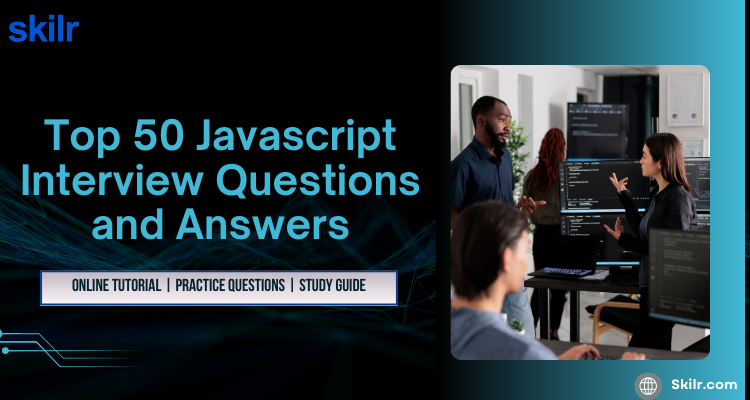JavaScript is the backbone of modern web development. Whether you are building dynamic user interfaces, integrating APIs, or managing backend logic with Node.js, JavaScript remains a core requirement for developers across roles and industries. Its flexibility, event-driven architecture, and evolving standards (like ES6+) make it both powerful and occasionally complex—especially in interview settings.
For this reason, JavaScript interviews are known to test not only your syntax knowledge but also your ability to think logically, reason through asynchronous code, and handle edge cases confidently.
This blog presents a curated list of 50 JavaScript interview questions and answers, grouped by difficulty level. Whether you are a beginner looking to land your first developer role or a full-stack engineer preparing for advanced technical rounds, this guide is designed to help you revise, practice, and strengthen your problem-solving abilities in JavaScript.
Target Audience
This blog is intended for a wide range of readers who want to strengthen their understanding of JavaScript, especially in preparation for technical interviews. Whether you are just starting your development journey or are preparing for mid- to senior-level roles, the content in this guide will help reinforce both conceptual clarity and coding confidence.
You will find this blog particularly useful if you are:
- A fresher or computer science graduate preparing for campus placements or entry-level frontend roles
- A frontend developer working with libraries and frameworks like React, Angular, or Vue
- A full-stack developer using JavaScript on both client-side and server-side (e.g., Node.js)
- A backend developer who occasionally works with JavaScript environments like Express or serverless functions
- A career switcher looking to transition into web development or software engineering
Each section is organized to help you understand not just the “what” but also the “why” behind JavaScript behavior—something that interviewers frequently assess.
Let us now begin with the Basic-Level JavaScript Interview Questions and Answers.
Basic-Level JavaScript Interview Questions (1–15)
1. What is JavaScript?
Answer:
JavaScript is a high-level, interpreted programming language primarily used to create interactive and dynamic web pages. It is supported by all modern browsers and plays a central role in front-end development. With environments like Node.js, JavaScript is also used for server-side development.
2. How is JavaScript different from Java?
Answer:
Despite their similar names, Java and JavaScript are entirely different languages:
- Java is a statically typed, compiled language used primarily for back-end and enterprise applications.
- JavaScript is a dynamically typed, interpreted language mainly used for web-based scripting.
They have different runtime environments, syntax rules, and use cases.
3. What are the different data types in JavaScript?
Answer:
JavaScript supports the following data types:
- Primitive types:
String,Number,Boolean,Undefined,Null,Symbol,BigInt - Non-primitive type:
Object(including arrays, functions, and more complex structures)
4. What is the difference between == and ===?
Answer:
==(loose equality) compares values after type coercion.===(strict equality) compares both value and data type without type conversion.
It is generally recommended to use===to avoid unexpected behavior.
5. What is the difference between var, let, and const?
Answer:
var: Function-scoped and can be re-declared and updatedlet: Block-scoped and can be updated but not re-declared in the same scopeconst: Block-scoped, must be initialized at declaration, and cannot be reassigned
6. What are truthy and falsy values in JavaScript?
Answer:
- Truthy: Values that evaluate to
truein a Boolean context (e.g., non-zero numbers, non-empty strings) - Falsy: Values that evaluate to
false(e.g.,false,0,'',null,undefined,NaN)
7. What is the difference between null and undefined?
Answer:
undefined: A variable that has been declared but not assigned a valuenull: An explicit assignment indicating “no value” or “empty”
They are different types:undefinedis a type itself, whereasnullis an object.
8. How do you write a comment in JavaScript?
Answer:
- Single-line comment:
// This is a comment - Multi-line comment:
/* This is a
multi-line comment */9. What are template literals in JavaScript?
Answer:
Template literals are string literals that allow embedded expressions using backticks:
let name = "Alice";
console.log(`Hello, ${name}`);10. What is type coercion in JavaScript?
Answer:
Type coercion is the automatic or implicit conversion of values from one data type to another (e.g., from string to number). JavaScript often performs coercion during equality comparisons or arithmetic operations.
11. What is an array in JavaScript?
Answer:
An array is an ordered collection of elements (of any type) indexed by integers starting from 0.
Example:
let fruits = ["apple", "banana", "cherry"];12. What is an object in JavaScript?
Answer:
An object is a collection of key–value pairs (properties) where keys are strings (or Symbols) and values can be any type.
Example:
let person = { name: "John", age: 30 };13. What are the different types of loops in JavaScript?
Answer:
JavaScript supports the following loop types:
forwhiledo...whilefor...in(used for object properties)for...of(used for iterable objects like arrays)
14. What is the use of the typeof operator?
Answer:
The typeof operator returns the data type of a variable.
Example:
typeof 123; // "number"
typeof "hello"; // "string"
typeof null; // "object"15. How do you convert a string to a number in JavaScript?
Answer:
Common methods include:
Number("123")parseInt("123")parseFloat("123.45")- Unary plus:
+"123"
Intermediate-Level JavaScript Interview Questions (16–30)
16. What is the difference between function declarations and function expressions?
Answer:
- Function declaration:
function greet() {
return "Hello";
}Hoisted entirely, including the function body.
- Function expression:
const greet = function() {
return "Hello";
};Only the variable is hoisted, not the function body.
17. What is hoisting in JavaScript?
Answer:
Hoisting is JavaScript’s default behavior of moving declarations (not initializations) to the top of their scope. Variables declared with var and function declarations are hoisted.
18. How does the this keyword work in JavaScript?
Answer:
The value of this depends on the execution context:
- In global scope: refers to the global object (
windowin browsers) - In a method: refers to the object that owns the method
- In strict mode:
thisisundefinedunless explicitly bound - In arrow functions:
thisis lexically bound (inherits from parent scope)
19. What are arrow functions and how do they differ from regular functions?
Answer:
Arrow functions are concise function expressions introduced in ES6.
Key differences:
- Do not bind their own
this - Cannot be used as constructors
- Cannot access
argumentsorsuper
Example:
const sum = (a, b) => a + b;20. How do you manipulate arrays using map(), filter(), and reduce()?
Answer:
map(): Transforms each element and returns a new arrayfilter(): Filters elements based on a conditionreduce(): Reduces the array to a single value
Example:
const numbers = [1, 2, 3];
const doubled = numbers.map(n => n * 2); // [2, 4, 6]
const evens = numbers.filter(n => n % 2 === 0); // [2]
const sum = numbers.reduce((acc, n) => acc + n, 0); // 621. What is event bubbling in JavaScript?
Answer:
Event bubbling is the process by which an event propagates from the innermost target element up through its parent elements. It allows event delegation but may require careful handling to prevent unintended side effects.
22. What is event delegation?
Answer:
Event delegation is a technique in which a single event listener is attached to a parent element to handle events triggered by its child elements. It improves performance and simplifies code, especially for dynamic content.
23. What are higher-order functions in JavaScript?
Answer:
Higher-order functions are functions that:
- Take other functions as arguments, or
- Return functions as their result
Examples:map(),filter(),reduce(),setTimeout(), and custom currying functions.
24. What is the difference between shallow copy and deep copy?
Answer:
- Shallow copy: Copies references to nested objects
- Deep copy: Creates independent copies of all nested objects
Example of shallow copy:Object.assign()or spread operator
Deep copy:JSON.parse(JSON.stringify(obj))(limited use), or recursive cloning
25. How does setTimeout() work?
Answer:setTimeout() schedules a function to run after a specified delay (in milliseconds).
It does not block the execution of other code and works with the browser’s event loop.
Example:
setTimeout(() => console.log("Hello after 1 second"), 1000);26. What is the difference between synchronous and asynchronous code?
Answer:
- Synchronous code runs sequentially and blocks further execution until it finishes.
- Asynchronous code allows other tasks to run while waiting for I/O operations (e.g., network requests) using callbacks, promises, or
async/await.
27. What are template literals and how are they used?
Answer:
Template literals are enclosed in backticks (`) and support embedded expressions using ${} syntax.
let name = "John";
console.log(`Hello, ${name}`);They also support multi-line strings and interpolation.
28. How do you clone an object in JavaScript?
Answer:
- Shallow copy:
const clone = { ...original };or
const clone = Object.assign({}, original);- Deep copy:
const deepClone = JSON.parse(JSON.stringify(original));(Caution: this fails for non-JSON values like functions or undefined)
29. What is the difference between call(), apply(), and bind()?
Answer:
call(): Invokes a function with a giventhisand arguments as a comma-separated listapply(): Similar tocall(), but arguments are passed as an arraybind(): Returns a new function with boundthis, without invoking it
Example:
func.call(obj, a, b);
func.apply(obj, [a, b]);
const boundFunc = func.bind(obj);30. What are default parameters in JavaScript?
Answer:
Default parameters allow function arguments to have predefined values if no value or undefined is passed.
function greet(name = "Guest") {
return `Hello, ${name}`;
}Advanced-Level JavaScript Interview Questions (31–40)
31. What is a closure in JavaScript?
Answer:
A closure is a function that retains access to its outer lexical scope even after the outer function has finished executing. Closures allow for data privacy and are commonly used in callbacks and module patterns.
Example:
function outer() {
let counter = 0;
return function inner() {
counter++;
return counter;
};
}
const increment = outer();
increment(); // 1
increment(); // 232. What is the event loop in JavaScript?
Answer:
The event loop is the mechanism that enables JavaScript to perform non-blocking asynchronous operations. It constantly checks the call stack and task queue, moving queued tasks (e.g., from setTimeout, promises) to the stack when it is clear.
33. What is the difference between microtasks and macrotasks?
Answer:
- Microtasks (e.g., Promises,
queueMicrotask) are executed after the current operation and before the next event loop iteration. - Macrotasks (e.g.,
setTimeout,setInterval) are queued for execution in future iterations of the event loop.
Microtasks have higher priority and are executed first.
34. What are Promises in JavaScript?
Answer:
A Promise is an object representing the eventual completion or failure of an asynchronous operation. It has three states: pending, fulfilled, and rejected.
Example:
let promise = new Promise((resolve, reject) => {
resolve("Success");
});
promise.then(result => console.log(result));35. What is async/await and how does it work?
Answer:async/await is syntactic sugar over Promises that allows writing asynchronous code in a synchronous style. An async function returns a Promise, and await pauses execution until the Promise resolves.
Example:
async function fetchData() {
const response = await fetch(url);
const data = await response.json();
return data;
}36. What is prototypal inheritance in JavaScript?
Answer:
In JavaScript, objects inherit properties and methods through a prototype chain. Every object has an internal link to another object called its prototype, which is used for property lookup.
Example:
function Person(name) {
this.name = name;
}
Person.prototype.greet = function() {
return `Hello, ${this.name}`;
};37. What is the difference between Object.create() and constructor functions?
Answer:
Object.create(proto)creates a new object with the specified prototype.- Constructor functions use the
newkeyword to initialize objects and allow instance-specific logic.
Example using Object.create():
const person = {
greet() { return "Hello"; }
};
const john = Object.create(person);38. How do JavaScript modules work?
Answer:
JavaScript modules (ES6) allow code to be split into reusable files.
- Use
exportto expose variables or functions - Use
importto access them in other files
Example:
// math.js
export function add(a, b) { return a + b; }
// app.js
import { add } from './math.js';Modules are scoped by default and help maintain clean, maintainable code.
39. What is memoization in JavaScript?
Answer:
Memoization is an optimization technique used to cache the results of expensive function calls and return the cached result when the same inputs occur again.
Example:
function memoize(fn) {
const cache = {};
return function (x) {
if (cache[x]) return cache[x];
cache[x] = fn(x);
return cache[x];
};
}40. What are service workers and how are they used?
Answer:
Service workers are scripts that run in the background and enable features like offline caching, background sync, and push notifications. They intercept network requests and serve cached responses if available.
Use cases include Progressive Web Apps (PWAs) and offline-first web design.
Scenario-Based JavaScript Interview Questions (41–50)
41. Write a function to debounce an input field.
Answer:
Debouncing limits the rate at which a function is executed, useful in search fields or resize events.
function debounce(func, delay) {
let timer;
return function (...args) {
clearTimeout(timer);
timer = setTimeout(() => func.apply(this, args), delay);
};
}42. How would you deep clone an object in JavaScript?
Answer:
For basic objects:
const deepClone = JSON.parse(JSON.stringify(obj));This method fails for functions, undefined, Date, etc.
For complex cases, use recursive cloning or libraries like Lodash (_.cloneDeep()).
43. Write a custom implementation of Array.prototype.map().
Answer:
Array.prototype.customMap = function (callback) {
const result = [];
for (let i = 0; i < this.length; i++) {
result.push(callback(this[i], i, this));
}
return result;
};44. How would you check if a string is a palindrome?
Answer:
function isPalindrome(str) {
const cleaned = str.toLowerCase().replace(/[^a-z0-9]/g, '');
return cleaned === cleaned.split('').reverse().join('');
}45. Write a function that flattens a nested array.
Answer:
function flatten(arr) {
return arr.reduce((acc, val) =>
Array.isArray(val) ? acc.concat(flatten(val)) : acc.concat(val), []);
}46. How would you implement a simple Promise.all()?
Answer:
function customPromiseAll(promises) {
return new Promise((resolve, reject) => {
let count = 0, results = [];
promises.forEach((p, i) => {
Promise.resolve(p).then(res => {
results[i] = res;
count++;
if (count === promises.length) resolve(results);
}).catch(reject);
});
});
}47. How do you throttle a function?
Answer:
function throttle(func, delay) {
let lastCall = 0;
return function (...args) {
const now = new Date().getTime();
if (now - lastCall >= delay) {
lastCall = now;
func.apply(this, args);
}
};
}48. Write a function to get the unique values from an array.
Answer:
function getUnique(arr) {
return [...new Set(arr)];
}49. How would you simulate a bind() function?
Answer:
Function.prototype.myBind = function (context, ...args) {
const fn = this;
return function (...newArgs) {
return fn.apply(context, [...args, ...newArgs]);
};
};50. Write a function to find the longest word in a sentence.
Answer:
function longestWord(sentence) {
return sentence.split(' ')
.reduce((longest, word) =>
word.length > longest.length ? word : longest, '');
}Core JavaScript Concepts to Revise
To perform well in a JavaScript interview, it is essential to go beyond syntax and demonstrate a solid understanding of how the language behaves under different conditions. Below is a structured list of important JavaScript topics you should revise to prepare confidently:
1. Variable Declarations and Scope
- Differences between
var,let, andconst - Block scope vs. function scope
- Temporal Dead Zone (TDZ)
- Variable hoisting
2. Functions and Execution Context
- Function declarations vs. expressions
- Arrow functions and lexical
this - Callback functions and higher-order functions
- Rest and spread operators (
...)
3. Closures and Lexical Environment
- Definition and practical uses of closures
- IIFE (Immediately Invoked Function Expressions)
- Memory implications of closures
4. The this Keyword
- Global context vs. object context
- Binding with
call(),apply(), andbind() - Behavior in arrow functions and event handlers
thisinside classes and constructors
5. Asynchronous JavaScript
- The event loop, call stack, task queue
- Promises and chaining with
.then()and.catch() async/awaitsyntax and error handling- Microtasks vs. macrotasks
6. Objects and Prototypes
- Creating and accessing object properties
- Understanding prototypal inheritance
- The prototype chain and property lookup
- Working with
Object.create(),Object.assign()
7. Arrays and Array Methods
- Core methods:
map(),filter(),reduce(),forEach(),find(),some(),every() - Immutability and shallow copies
- Array destructuring and iteration techniques
8. Error Handling and Debugging
try,catch,finallysyntax- Throwing custom errors
- Using
consolemethods and browser DevTools - Debugging async code
9. Modules and Code Organization
importandexportsyntax in ES6- Named exports vs. default exports
- Benefits of modular architecture
10. DOM and Event Handling (if frontend-focused)
- Selecting and manipulating DOM elements
- Adding and removing event listeners
- Event bubbling, capturing, and delegation
- Working with forms and user input
By revisiting these core topics, you will not only improve your technical accuracy but also gain the ability to explain complex behaviors clearly—something that interviewers consistently value. Be sure to complement this review with practical coding exercises and mock interviews.
Conclusion
JavaScript continues to be a cornerstone of web development, powering everything from simple client-side interactions to full-fledged front-end frameworks and server-side applications. Whether you are preparing for a frontend, backend, or full-stack developer role, demonstrating a solid grasp of JavaScript fundamentals and modern features is essential in technical interviews.
Consistency in practice and clarity in thought are what distinguish successful candidates. Approach your interviews with curiosity, preparation, and confidence—and you will be well on your way to success in JavaScript roles.





